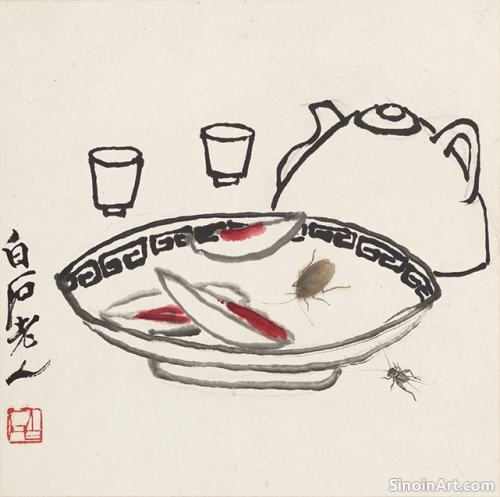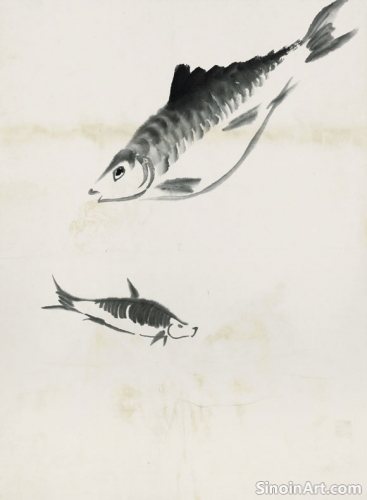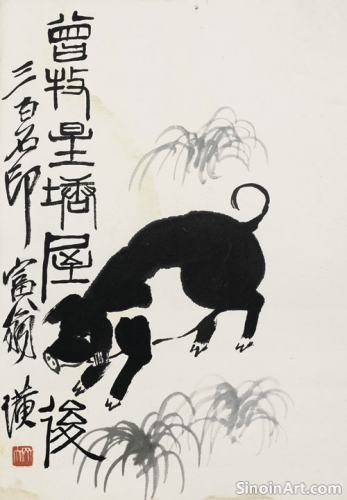The Use of "Multiple Brushstrokes" in Xieyi
|
"Multiple Brushstrokes," or cūn fǎ (皴法), are a series of textured brushstrokes used in Xieyi painting, particularly in landscape paintings, to create a sense of depth, texture, and form. These strokes are often used to depict mountains, rocks, and trees, adding visual complexity and depth to the artwork. They represent the accumulated knowledge of Xieyi masters across history.  There are many different types of cūn fǎ, each with its own unique characteristics and expressive qualities. Some of the most common include "axe-cut" strokes, "hemp-fiber" strokes, and "raindrop" strokes, each suggesting different textures and forms. The techniques provide a wide expressive range. The use of "multiple brushstrokes" allows the artist to create a sense of three-dimensionality, suggesting the volume and depth of the landscape. They also can be used to represent lighting effects. They are a valuable technique for creating a sense of realism within the art form.  The application of cūn fǎ requires a high level of skill and a deep understanding of brushwork. The artist must be able to create lines that are both textured and expressive, often layering strokes to add depth and visual interest. It is a technique that requires a lot of practice and dedicated study.  The strategic application of these brushstrokes can guide the viewer’s eye through the composition, creating a sense of movement and rhythm and adding visual complexity and dynamism. It is a key technique for building landscapes from simple brushstrokes. It adds both complexity and a sense of movement. |
Tag : multiple brushstrokes, textured lines, landscape technique, Xieyi method
Related information
- The Significance of Composition in Xieyi
- Xieyi Painting and the Use of "Contrasting Ink"
- Xieyi Painting and the Depiction of Bamboo
- Xieyi Painting and the Concept of "Yuan Qi"
- The Influence of the "Four Gentlemen" on Xieyi Subjects
Composition, including the strategic use of negative space, asymmetrical balance, and flowing lines, is vital in Xieyi painting, guiding the viewer's eye, creating a sense of harmony, and supporting the artist's intention, despite the art form's seemingly spontaneous nature.
"Contrasting Ink" (nóngdànmò) in Xieyi uses both dark and light ink strategically to create depth, volume, texture, and atmosphere through visual contrast, with dark ink creating boldness and light ink adding distance and subtlety, requiring skilled blending to create tonal gradations, expressive depth, and nuanced interplay of light and shadow.
Bamboo is a popular subject in Xieyi painting, valued for its elegant form, resilience, and rich symbolic meaning, with artists using bold, fluid brushstrokes and calligraphic lines to capture its essence, its vital energy, and to express core values of integrity, resilience, and a meditative connection to nature.
"Yuan Qi" (original vital energy) is a core concept in Xieyi, representing the fundamental creative energy of the universe, pursued by artists aiming to capture the inner essence and inherent vitality of their subjects, requiring balance, mindfulness, and a deep connection with nature, imbuing their works with a sense of purpose and powerful intent.
The "Four Gentlemen" (sìjūnzǐ) – plum blossom, orchid, bamboo, and chrysanthemum – are highly revered subjects in Xieyi, each embodying distinct virtues like resilience, refinement, integrity, and longevity, serving as a rich source of inspiration for artists expressing a range of emotions and philosophical ideas.